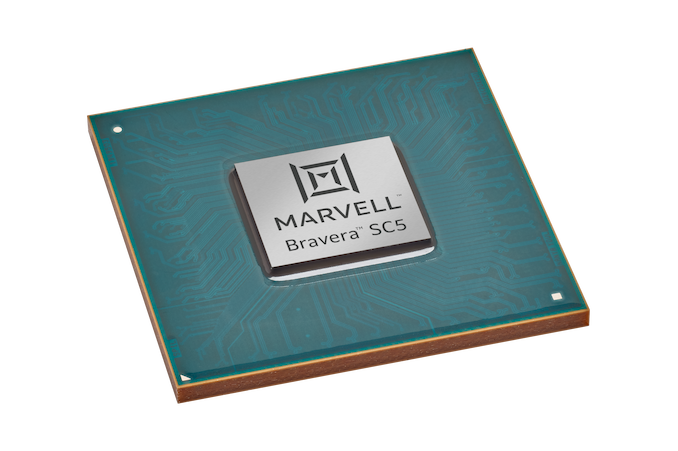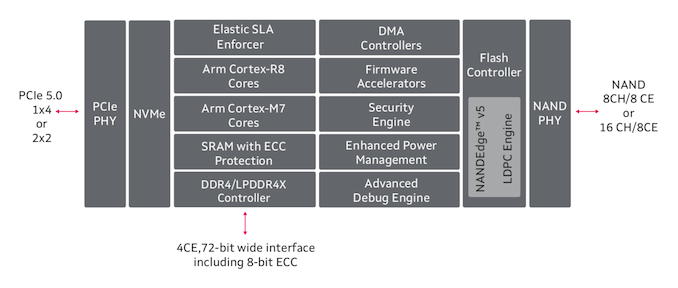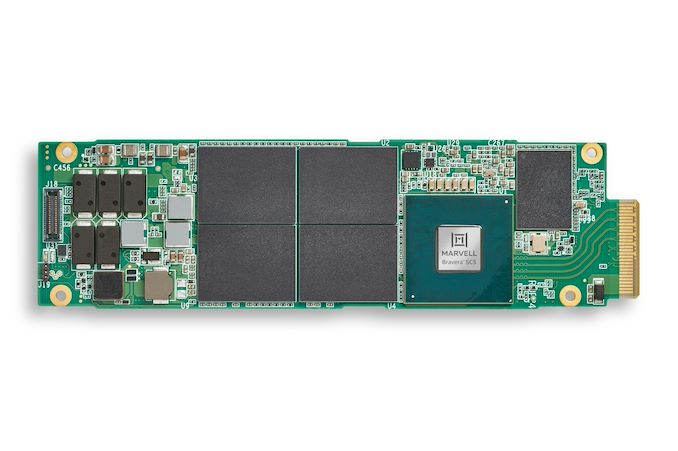Marvell Announces First PCIe 5.0 NVMe SSD Controllers: Up To 14 GB/s
by Billy Tallis on May 27, 2021 8:30 AM EST
Today Marvell is announcing the first NVMe SSD controllers to support PCIe 5.0, and a new branding strategy for Marvell's storage controllers. The new SSD controllers are the first under the umbrella of Marvell's Bravera brand, which will also encompass HDD controllers and other storage accelerator products. The Bravera SC5 family of PCIe 5.0 SSD controllers will consist of two controller models: the 8-channel MV-SS1331 and the 16-channel MV-SS1333.
| Marvell Bravera SC5 SSD Controllers | ||||||
| MV-SS1331 | MV-SS1333 | |||||
| Host Interface | PCIe 5.0 x4 (dual-port x2+x2 capable) | |||||
| NAND Interface | 8ch, 1600 MT/s | 16ch, 1600 MT/s | ||||
| DRAM | DDR4-3200, LPDDR4x-4266 with ECC | |||||
| Sequential Read | 14 GB/s | |||||
| Sequential Write | 9 GB/s | |||||
| Random Read | 2 M IOPS | |||||
| Random Write | 1 M IOPS | |||||
| Max Controller Power | 8.7 W | 9.8 W | ||||
| Virtualization | 16 Physical Functions, 32 Virtual Functions | |||||
These new SSD controllers roughly double the performance available from PCIe 4.0 SSDs, meaning sequential read throughput hits 14 GB/s and random read performance of around 2M IOPS. To reach this level of performance while staying within the power and thermal limits of common enterprise SSD form factors, Marvell has had to improve power efficiency by 40% over their previous generation SSD controllers. That goes beyond the improvement that can be gained simply from smaller fab process nodes, so Marvell has had to significantly alter the architecture of their controllers. The Bravera SC5 controllers still include a mix of Arm cores (Cortex-R8, Cortex-M7 and a Cortex-M3), but now includes much more fixed-function hardware to handle the basic tasks of the controller with high throughput and consistently low latency.
Such an architectural shift often means sacrificing flexibility, but Marvell doesn't expect that to be a problem thanks in large part to the Open Compute Project's Cloud SSD specifications. Those standards go beyond the NVMe spec and define which optional features should be implemented, plus target performance and power levels for different form factors. The Cloud SSD specs were initially a collaboration between Microsoft and Facebook but have caught on in the broader market and even have the support of traditional enterprise server vendors like Dell and HP. This allows controller vendors like Marvell and SSD manufacturers to more narrowly focus their product development efforts, and to target a wider range of customers with a single hardware and firmware platform. In spite of the shift toward more fixed hardware functionality, the Bravera SC5 controllers still support a wide range of features including NVMe Zoned Namespaces (ZNS), Open Channel SSDs and Kioxia's Software-Enabled Flash model.
In addition to being the first available PCIe 5.0 SSD controllers, the Bravera SC5 family includes the first 16-channel controller designed to fit on the EDSFF E1.S form factor, using a controller package size of 20x20 mm with peak controller power of 9.8 W. The new controllers are currently sampling to select customers, with the option of using Marvell's firmware or developing custom firmware.












47 Comments
View All Comments
MenhirMike - Thursday, May 27, 2021 - link
Wow, 9W power just for the controller is quite something. Not criticizing them of course, this is not meant for some Laptop SSD, but it's funny to see a regular DataCenter Hard Drive be rated at around 8.5W (UltraStar DC HC 530 SAS) while this is 9W just for the controller, not counting the Flash.Then again, you don't get to 1M IOPS and 14 GB/s transfer rate for free.
Xajel - Thursday, May 27, 2021 - link
I guess when we're closing the consumer mobile version they will already use better process tech to lower the power envelope.mode_13h - Thursday, May 27, 2021 - link
> consumer mobile versionLOL
Mikewind Dale - Thursday, May 27, 2021 - link
My guess is that consumer mobile versions will be using fewer lanes. PCIe 5.0 x1 will have the same bandwidth as PCIe 3.0 x4, and PCIe 5.0 x2 will have the same as PCIe 4.0 x2.For consumer uses, I think we might actually soon hit the point of diminishing returns for storage. Just the improvement to random access obtain moving from HDD to SATA SSD already achieved the majority of the returns for consumer uses.
I'm not saying that faster storage won't benefit consumers, but I think that for consumers, advances in storage won't be any more remarkable than advances in CPUs. For someone who edits Word documents and browses the internet and watches movies, the move from one generation of CPUs to another is a nice improvement, but it won't change their life. Now, the move from HDD to SATA SSD *did* utterly transform the way a consumer uses their computer, but I think that we've reached the point of diminishing returns.
Therefore, I suspect that for a lot of consumer uses, new versions of PCIe will translate into fewer lanes (and therefore higher battery life), rather than faster data transfer speeds.
Mikewind Dale - Thursday, May 27, 2021 - link
"and PCIe 5.0 x2 will have the same as PCIe 4.0 x2"Derp, I meant PCIe 4.0 x4"
Santoval - Saturday, May 29, 2021 - link
"PCIe 5.0 x1 will have the same bandwidth as PCIe 3.0 x4, and PCIe 5.0 x2 will have the same as PCIe 4.0 x2."I doubt we are ever going to see a single lane SSD, even if it made sense -at first glance- for its target market. It would make far more sense, and would almost certainly be cheaper and more robust (a single PCIe 5.0 lane would be quite weaker, more susceptible to noise and less far-reaching than two PCIe 4.0 lanes all else being equal) to just use two PCIe 4.0 lanes.
drmaddogs - Saturday, June 19, 2021 - link
No more Gallium and much more small.. coming over ten years.Daviii - Thursday, May 27, 2021 - link
9W is the max controller power. My guess is that's the peak consumption in those (admittedly rare) scenarios of sustained 14GB/s transfers?Billy Tallis - Thursday, May 27, 2021 - link
Yes, the controller power will only get that high when using the full performance. In such scenarios, the whole drive power will probably be in the 25W range (E1.S with heatsink). Some customers are likely to use these controllers in more power-limited enclosures/systems, where 14GB/s per drive will not be attainable.mode_13h - Thursday, May 27, 2021 - link
> 9W power just for the controller is quite something.If performance increased by enough, then perf/W could still be better than previous gen.